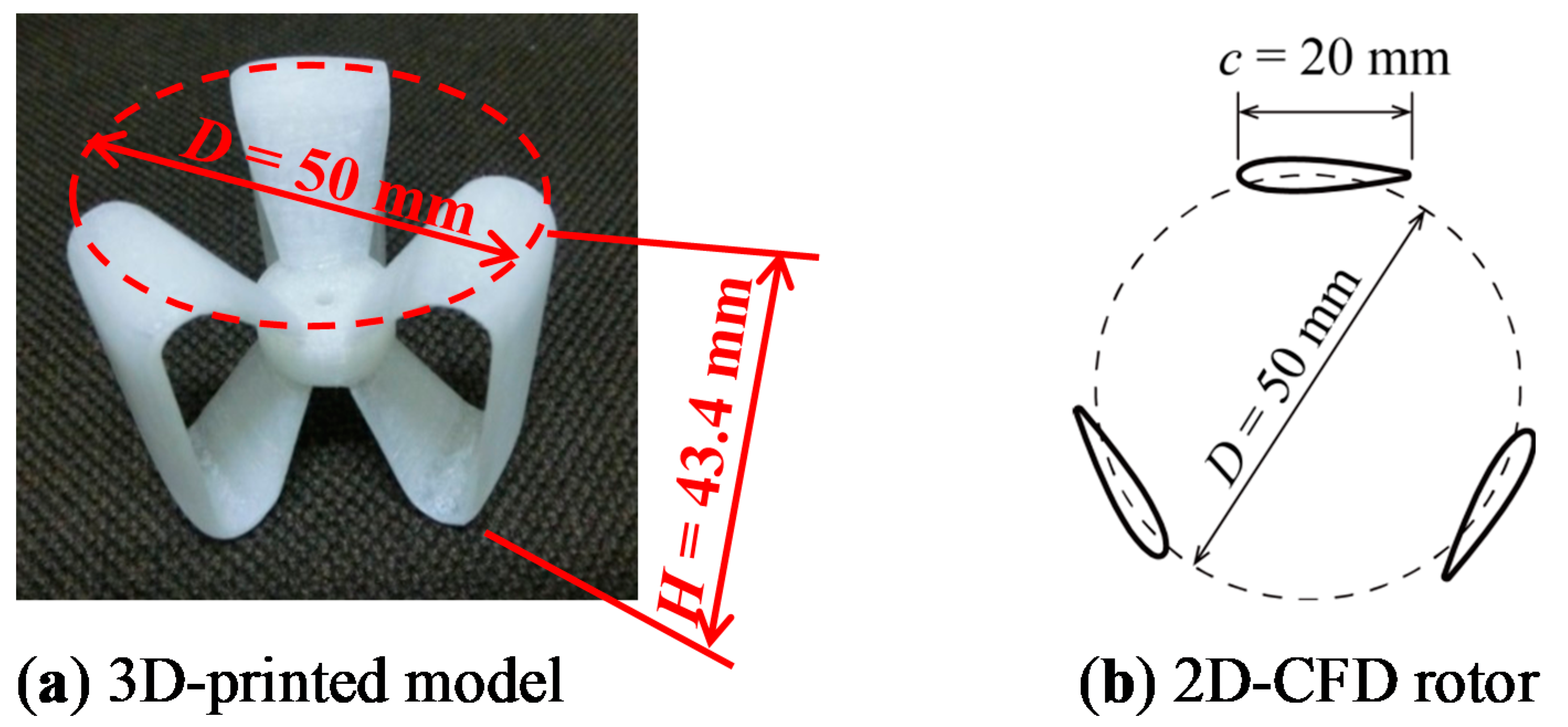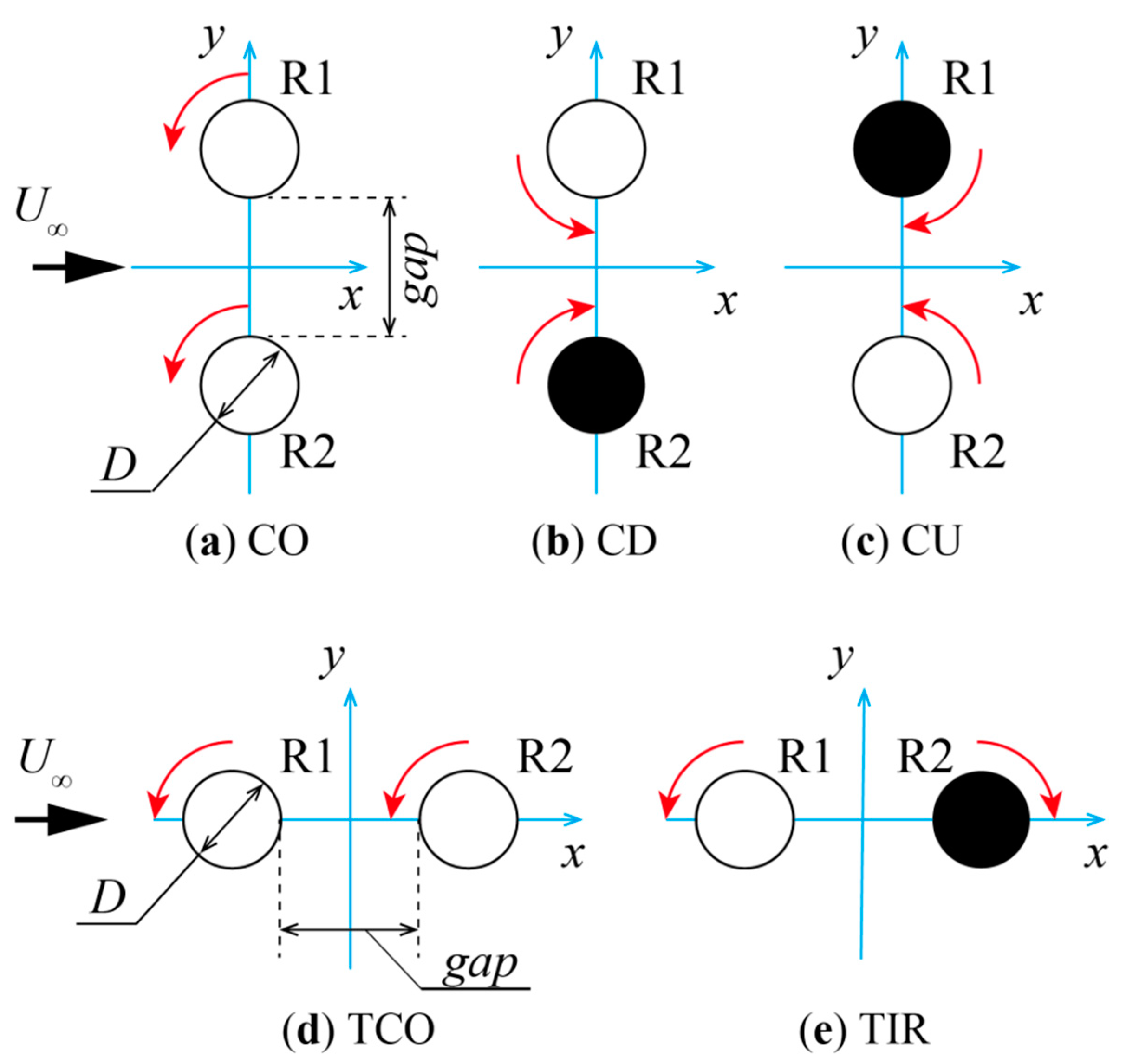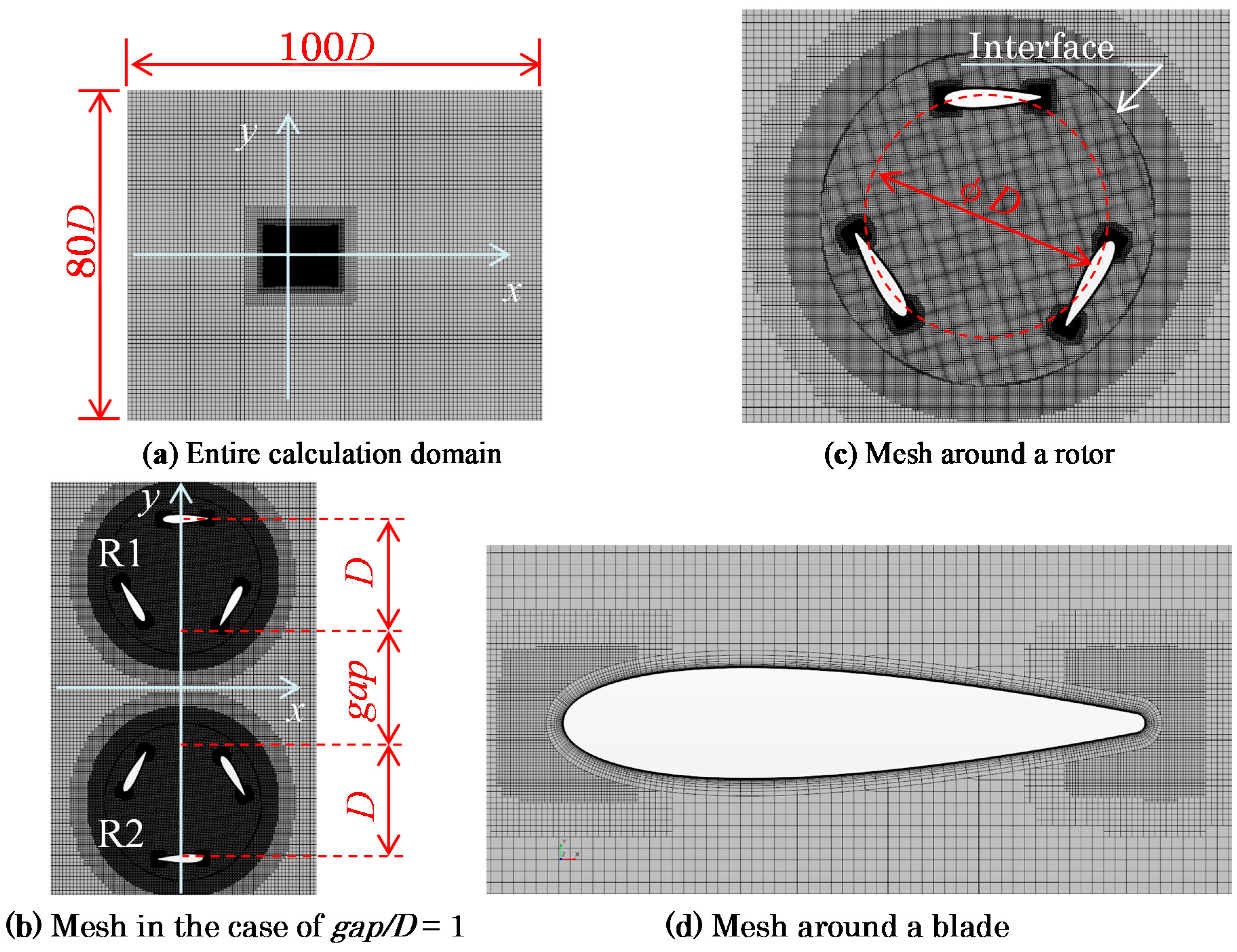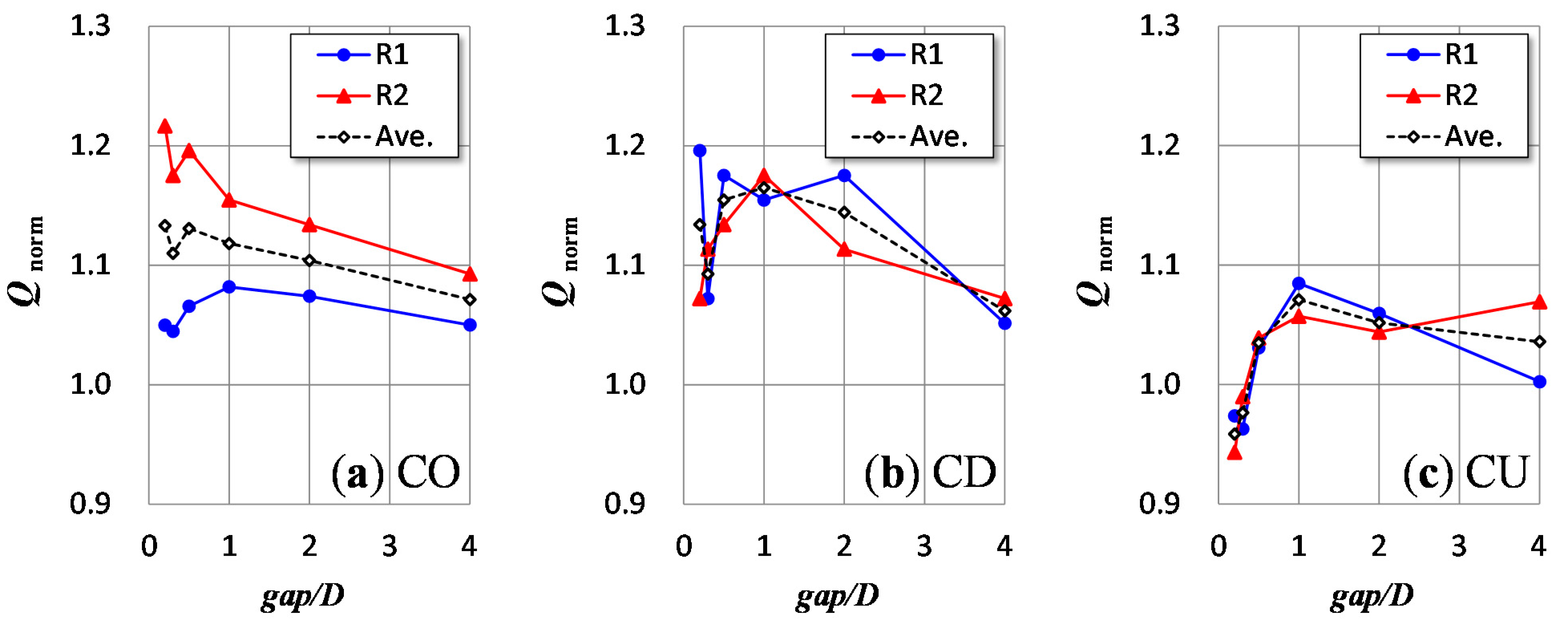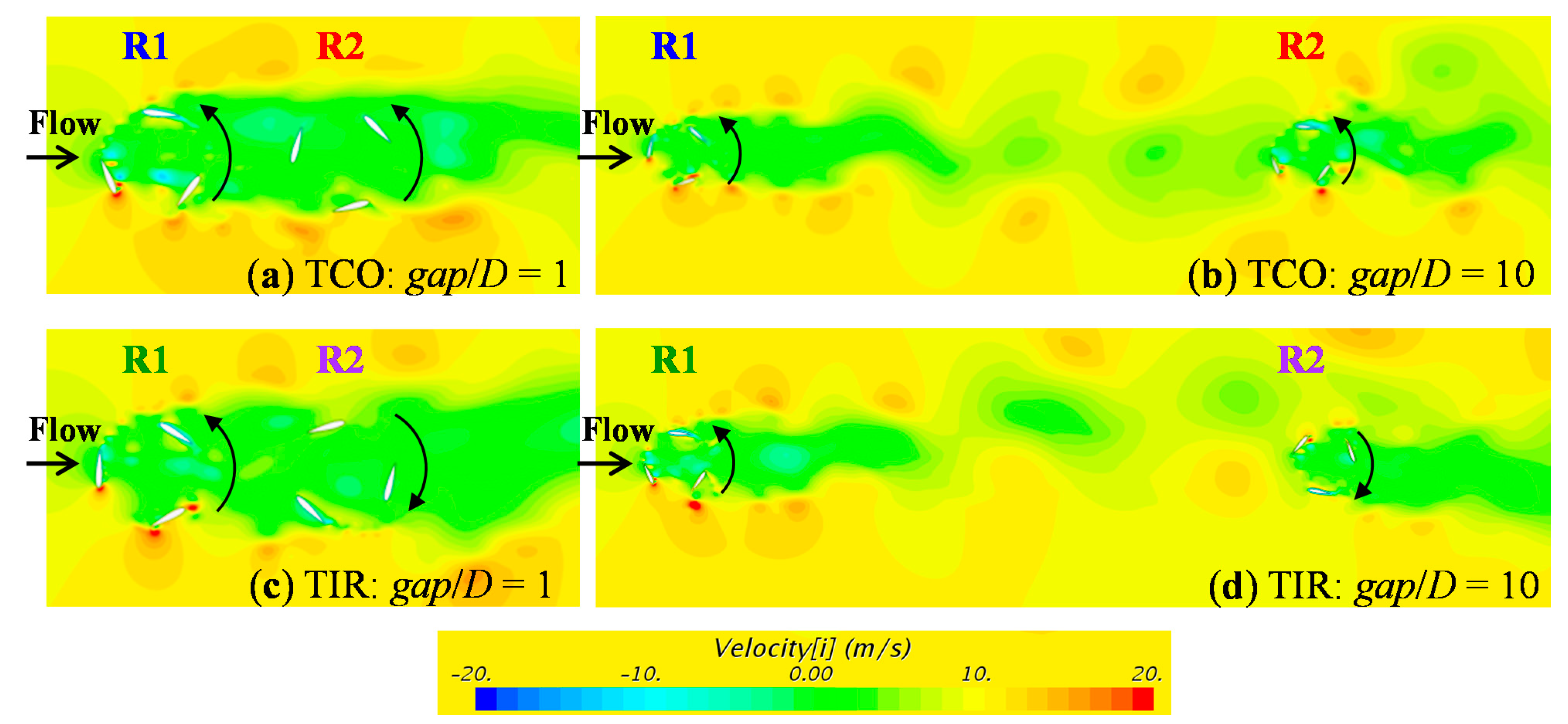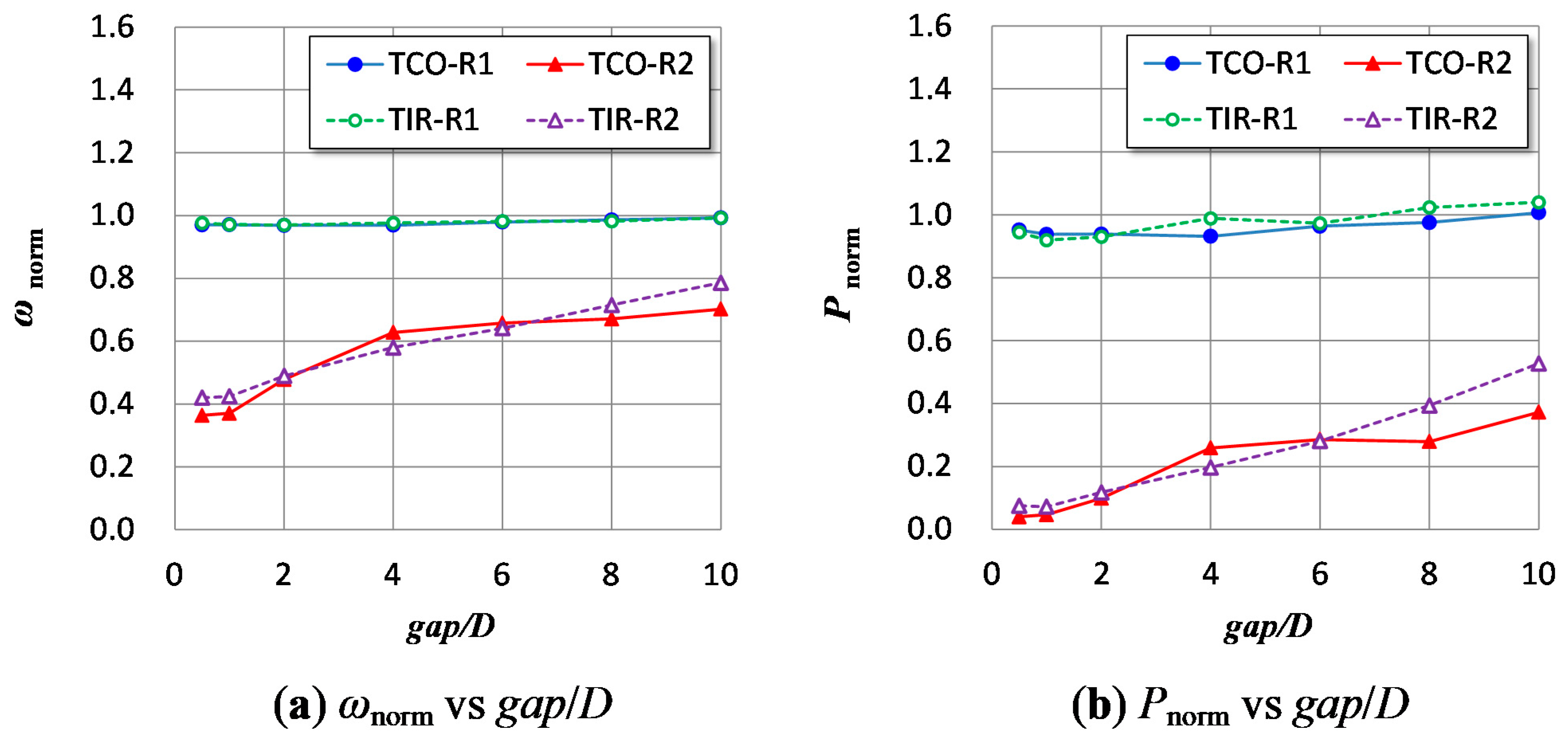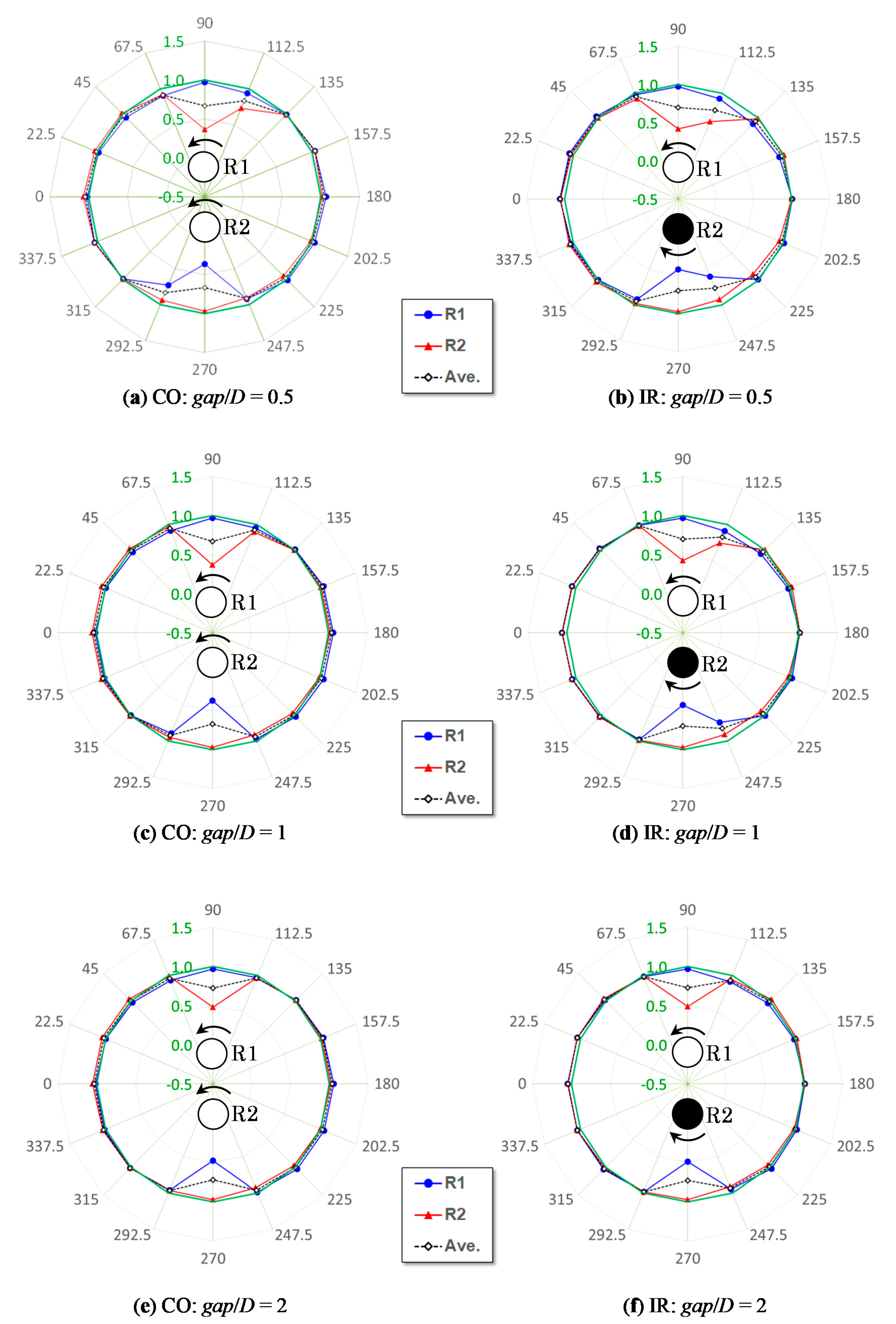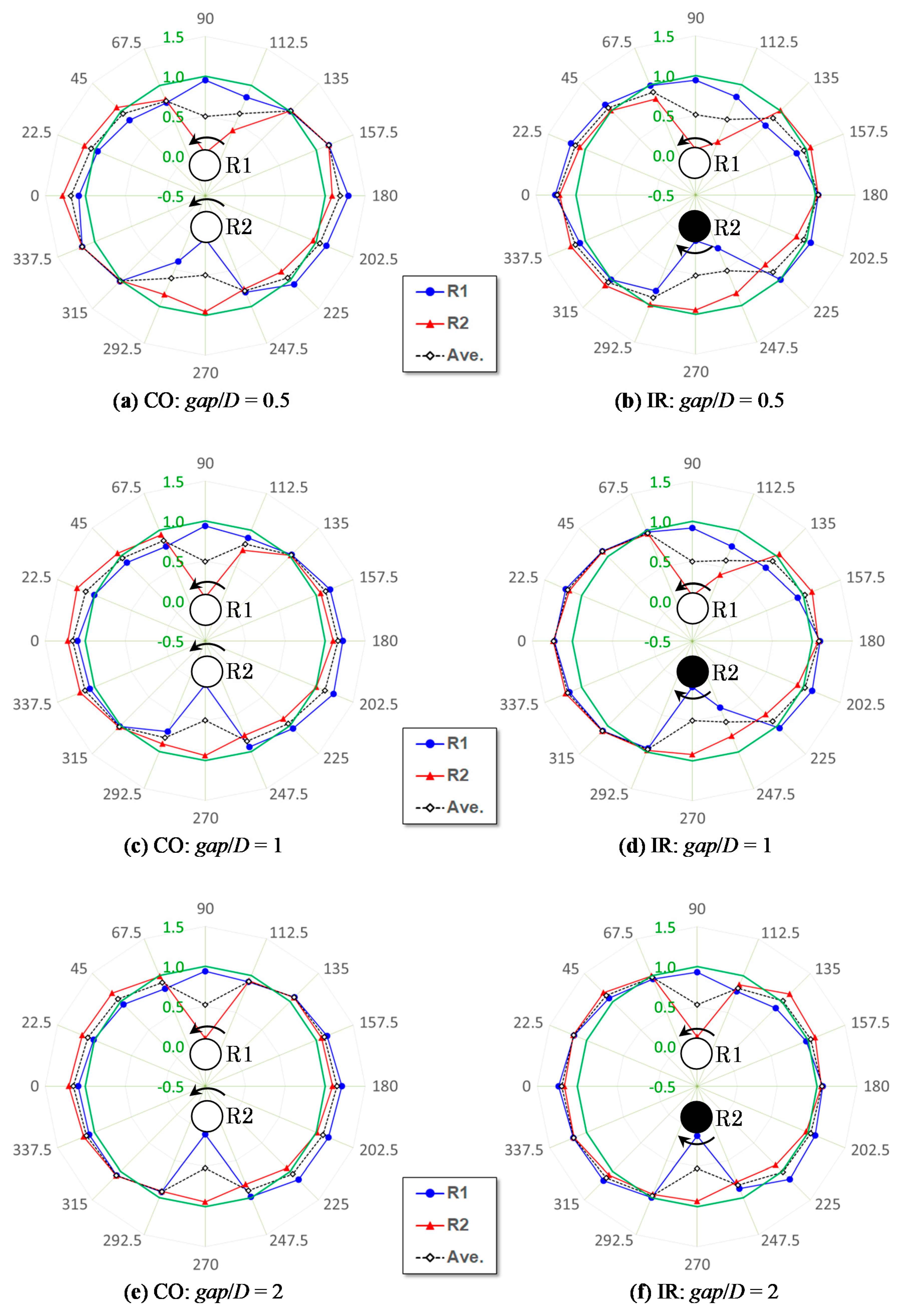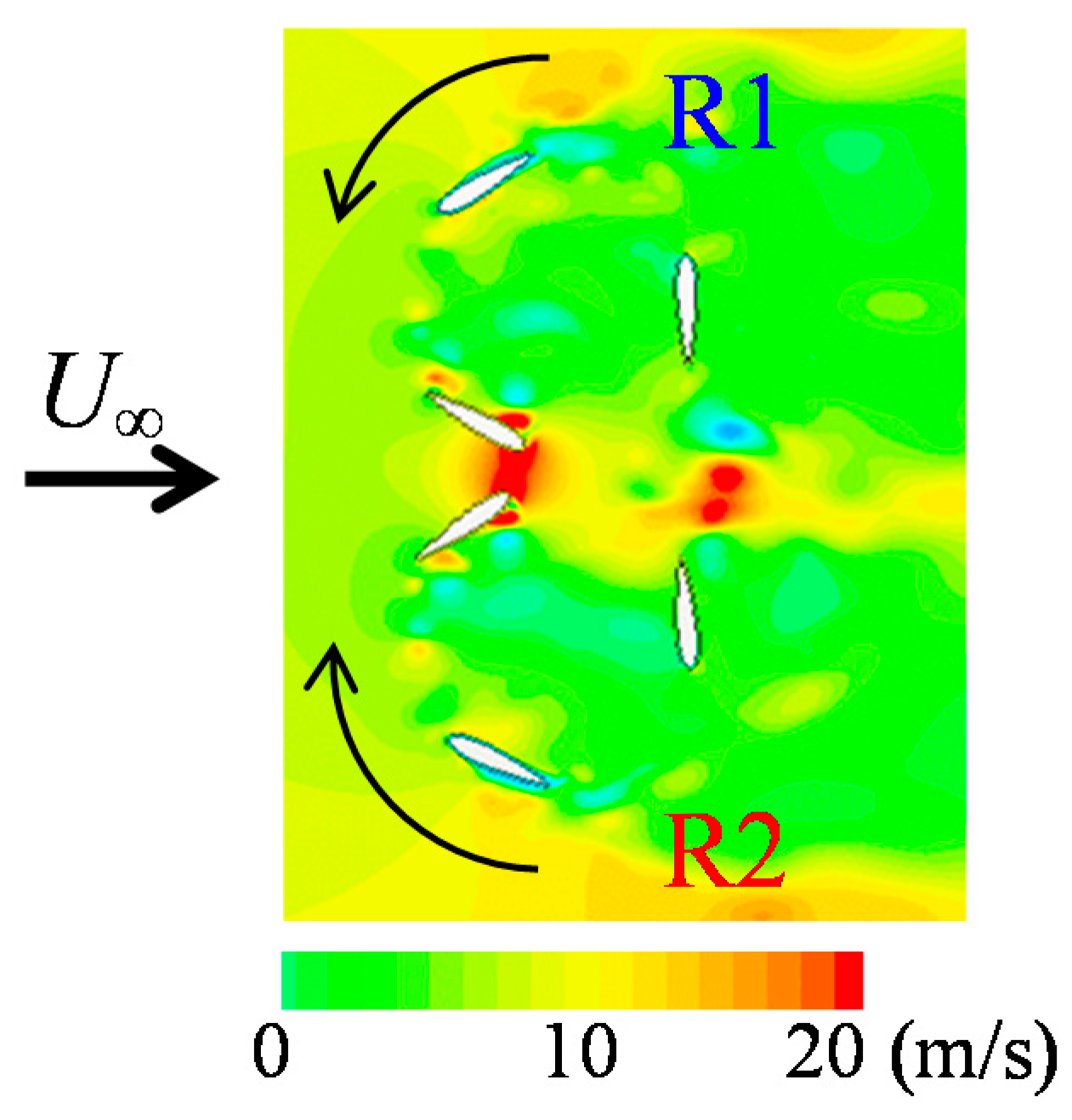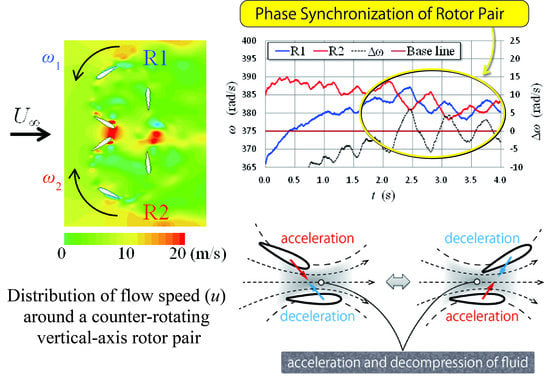1. Introduction
In a wind farm comprising numerous large-scale horizontal-axis wind turbines (HAWTs), the distance between adjacent turbine rotors must be several times longer than the rotor diameter. Otherwise, the power output will decrease significantly when a turbine is located in the wake of an upstream turbine. By predicting the wake of the turbines [
1,
2], the optimal layout of turbines that maximizes the wind farm power density (output per unit land area) can be identified—an important issue in the wind power field. Although vertical-axis wind turbines (VAWTs) do not prevail currently, as the basis for considering the optimal layout of the VAWT wind farm, Rajagopalan et al. conducted computational fluid dynamics (CFD) simulations assuming a two-dimensional (2D) laminar flow field [
3]. Their results indicated that the rotors on the downwind side, but outside of the wake, produced a higher power output than the first-row rotors that faced the undisturbed flow owing to the interactions between the VAWT rotors. Meanwhile, Dabiri et al. proposed the possibility of closely spaced counter-rotating VAWT arrays, which can enhance the wind farm power density to a greater degree than existing HAWT wind farms; they conducted a numerical simulation based on a potential flow model incorporating velocity deficit [
4] and field experiments using actual small VAWTs (Windspire: 1.2 kW) [
5,
6]. CFD analyses targeting a counter-rotating VAWT pair, which was used by Dabiri as a basis for the rotor array, have been recently conducted by many researchers. Zanforlin and Nishino performed 2D-CFD simulations of rotor models corresponding to Windspire and demonstrated that a counter-rotating closely spaced VAWT pair can produce a larger power output than an isolated single turbine [
7]. Chen et al. conducted a 2D-CFD simulation targeting a straight-bladed VAWT pair and investigated the effects of five factors, i.e., inflow angle, tip speed ratio, turbine spacing, rotational direction, and blade angle, on the performance of a dual-turbine system [
8]. Their results indicated that the power output of the rotor pair depended primarily on the tip speed ratio and inflow angle. De Tavernier et al. [
9] comprehensively investigated the effects of rotor load (solidity), rotor spacing, and inflow angle on the flow and power output of a closely spaced 2D rotor pair (rotor radius = 10 m) via a 2D-CFD simulation based on a panel/vortex model. Ma et al. performed a 2D-CFD analysis to simulate a vertical-axis twin-rotor tidal current turbine, in which the two rotors revolved in opposite directions [
10]. Based on the analysis, the maximum power coefficient was obtained at a tip speed ratio of 1.5, where the ratio of the rotor spacing to the diameter in the layout of the main flow perpendicular to the centerline connecting the two rotor centers was 9/4. As the rotor spacing became smaller than the optimal value, the power output decreased. As a special case corresponding to the ultimate close arrangement of the VAWT rotors, using three-dimensional (3D) CFD analysis, Poguluri et al. [
11] investigated the 3D effects, such as the interaction of the tip vortices, of a co-axial contra-rotating VAWT (CR-VAWT) consisting of two mutually counter-rotating VAWT rotors with a common rotational axis and a small vertical gap between them. Although the output power of the CR-VAWT is lesser than that of a conventional VAWT, the total rotational moment and the side-to-side force perpendicular to the main flow, both acting against the tower base, may be cancelled out owing to the use of counter-rotation in the VAWT pair. In all five CFD analyses, the rotational speeds of two rotors were fixed to the same value in each run of the calculation. In terms of basic studies pertaining to a rotor pair normal to the main flow, Bearman and Wadcock [
12] experimentally investigated the interaction between a circular cylinder pair, whereas Yoon et al. [
13] performed a CFD analysis on a rotating circular cylinder pair. The flow patterns around a circular cylinder pair might be analogous to the flow patterns around a turbine rotor pair in terms of spacing dependence. However, it is important to recognize the essential difference in the manner by which vortices are shed between a solid circular cylinder and a turbine rotor comprising blades. Recently, Vergaerde et al. [
14] performed experiments using a closely spaced pair of straight-bladed VAWTs that mutually revolved in opposite directions in a wind tunnel and observed their phase synchronization. The first author of this paper and his colleagues have proposed a concept named “Wind Oasis” [
15], which applies a wind farm comprising small-scale vertical-axis-type butterfly wind turbines (BWTs) [
16] for agriculture in drylands to pump water for crops and to generate electricity for people. As basic studies for materializing this concept, the authors of the present paper have been conducting wind tunnel experiments using miniature BWT models and performing the 2D-CFD analysis of the corresponding rotors. Although not described in detail herein, Jodai et al. [
17,
18] observed phase synchronization in their experiments on a closely spaced miniature BWT pair as well.
In this study, to determine the optimal layout of a VAWT wind farm, a CFD analysis of a 2D vertical-axis rotor pair was performed considering the dynamic interaction between a fluid and wind turbines (i.e., the dynamic fluid-body interaction, DFBI [
19]). In contrast to the aforementioned conventional CFD simulations, in this study, the rotational speed of each rotor was not fixed to a constant value but was simulated based on the equation of motion of the rotor. This CFD analysis using the DFBI is equivalent to experiments involving variable-speed wind turbines. Although some of the results have been reported in several oral presentations [
20,
21,
22,
23] and in a commentary article [
15], they are integrated herein and new considerations and results are included; furthermore, the calculation times of some cases were prolonged until the rotor angular velocities converged within the new criteria. The details of the revised data acquisition are explained in the following section. The results were as follows. In the parallel layouts perpendicular to the main flow, the counter-down (CD) layouts (the blades move downwind in the gap) yielded a higher mean power than that of the counter-up (CU) layouts (the blades move upwind in the gap). By assuming an isotropic bidirectional wind speed, the co-rotating layouts (CO: two rotors in the parallel layout with the same rotational direction) were found to be superior to the combination of the CD and CU layouts in terms of mean output power at all gap lengths. In the tandem layouts along the main flow, the inverse-rotation (IR) configuration demonstrated an earlier recovery in terms of the mean rotor power in comparison with that of the CO configuration as the gap length increased. The analysis results of the 16-wind-direction configurations are discussed in detail. Finally, the phase synchronization of a rotor pair is demonstrated via CFD analysis and discussed.
2. Methods
In this study, a CFD analysis was performed using a 2D rotor, as shown in
Figure 1b (hereinafter 2D-CFD rotor) as a target, which corresponds to the equator-level cross section of a 3D printed model, as shown in
Figure 1a (hereinafter 3D-EXP rotor). The 3D-EXP rotor (diameter:
D = 50 mm, height:
H = 43.4 mm, chord length:
c = 20 mm, blade cross section: NACA 0018) was used in the wind tunnel experiments performed in another study in parallel [
17]. The 2D-CFD rotor did not include the hub and slant blade parts of the 3D-EXP rotor. The solidity of the 2D-CFD rotor used in this study was
σ =
Bc/(π
D) = 0.38 (
B: number of blades), which is larger than the solidity (
σ = 0.10) of the rotor of Zanforlin and Nishino [
7], that (
σ = 0.15) of the rotor of Chen et al. [
8], that (
σ = 0.032) of the rotor of De Tavernier et al. [
9], and that (
σ = 0.176) of the rotor of Ma et al. [
10]. The trailing edges of the blades of the 2D-CFD rotor were designed to be rounded with the curvature radius of 0.32 mm, in accordance with the 3D-EXP rotor.
In this study, the commercial application software STAR-CCM+ ver.14.04.011 was used as the numerical solver. The 2D unsteady incompressible Reynolds-averaged Navier-Stokes equations and the equation of continuity were solved by adopting the
k–ω shear stress transport turbulence model [
24]. A trim mesh was selected for the entire domain except for the region near the blade surfaces, where a prism layer mesh was used to create 15 layers that thinned progressively. The rotating motion of the rotor was realized using the overset mesh method. First, the torque performance (
Q vs.
ω;
Q is the torque, and
ω is the angular velocity) of an isolated single rotor was simulated at four wind speeds (
U∞ = 6, 8, 10, and 12 m/s). The entire calculation domain of the CFD analysis of the single rotor was a rectangle measuring 40
D × 50
D; the rotor center was positioned at 20
D from the inlet boundary. Each run of the calculations were performed under a fixed rotational speed and was continued until the 10th rotor rotation was completed. The torque in the last five rotations of each run was averaged, and the results are shown in
Figure 2.
The data depicted in
Figure 2 were obtained by converting the 2D results into values corresponding to a 3D-EXP rotor. However, these data do not include the tip vortex loss and the effects of slant blades and a hub because of 2D-CFD. Therefore, in comparison with the measured torque performance [
18] of the 3D-EXP rotor, the maximum torque depicted in
Figure 2 was approximately 1.3 times larger, and the angular velocity corresponding to the maximum torque was approximately 1.5 times greater than the experimental data. Additionally, the torque performance in the low-angular-velocity region differed between the experimental and CFD results. However, the shapes of the torque curves obtained by the experiments and CFD analysis were typically similar in the regions around a torque peak and those of higher angular velocity.
The 2D calculation in STAR-CCM+ provided results that corresponded to the model with unit thickness, i.e., 1 m. Therefore, all the raw output values of the CFD analysis were multiplied by 0.0434, as shown in
Figure 2, to convert them into torque values corresponding to those of the 3D-EXP rotor. The curve in red in
Figure 2 represents the ideal load torque that passes a point that is 95% of the maximum power obtained via CFD analysis for a wind speed of 10 m/s. The load torque
QL [N m] is expressed as follows:
In the CFD analysis based on the DFBI method, the time-dependent angular velocity of each rotor is determined by solving the following equation of motion:
In Equation (2), I is the moment of inertia of each rotor. When the mass of 3D-EXP rotor was assumed to be 14 g, the moment of inertia was estimated to be 5.574 × 10−6 kg m2 based on a computer-aided design model. For the actual CFD analysis, the value of I = 5.574 × 10−6 kg m2 × 1000 mm/43.4 mm = 1.284 × 10−4 kg m2 was set in STAR-CCM+ because the 2D-CFD rotor had a unit length height. The QR term on the right-hand side of Equation (2) represents the rotational torque of each rotor obtained from CFD calculation. As for the load torque QL, the value of 1000/43.4 × Equation (1) (i.e., 8.55 × 10−8 ω2) was set in STAR-CCM+.
The parallel layouts of the two rotors, in which the line connecting the two rotor centers (
y-axis direction) is perpendicular to the main flow (
x-axis direction), include the three layouts shown in
Figure 3a–c. In the CO layout (
Figure 3a), the upper rotor (Rotor 1: R1) and lower rotor (Rotor 2: R2) rotate in the same direction; in the CD layout (
Figure 3b), R1 and R2 rotate in different directions, and the blades move in the same direction as the main flow between the two rotor centers; in the CU layout (
Figure 3c), the two rotors revolved in different directions and the blades moved against the main flow between the rotor centers. The terminology for the parallel layouts is based on De Tavernier et al. [
9]. In this study, the CFD analysis was performed using the DFBI method (hereinafter DFBI-CFD) on a rotor pair comprising two 2D-CFD rotors in the aforementioned three parallel layouts, i.e., CO, CD, and CU, with different rotor spacings (gaps) of 10, 15, 25, 50,100, and 200 mm.
The tandem layouts of the two rotors, in which the line connecting the two rotor centers is parallel to the main flow direction, are classified into the two layouts shown in
Figure 3d,e. In this study, the layouts shown in
Figure 3d,e are classified as the tandem co-rotating (TCO) and tandem inverse-rotating (TIR) layouts, respectively. The DFBI-CFD analysis was performed for the TCO and TIR layouts with the gaps of 25, 50,100, 200, 300, 400, and 500 mm.
After executing the DFBI-CFD calculations for the parallel and tandem layouts, the 16-wind-direction configurations shown in
Figure 4 were analyzed using similar methods. The cases shown in
Figure 4a, in which two rotors rotate in the same direction, are defined as the CO configurations, whereas the cases shown in
Figure 4b, in which two rotors rotate mutually in different directions, are termed as IR configurations in the present study. The coordinate system (
xR,
yR) depicted in
Figure 4 is fixed at the rotor pair, and the origin is placed at the center of the rotor pair. The origin of the wind-direction angle
θ is defined in the left-hand side of the rotor pair, i.e., as the direction of –
xR, in this analysis. For the five specific layouts shown in
Figure 3, the CO layout corresponds to the case of
θ = 0° in the CO configurations; the case of
θ = 180° is identical to the CO layout and is not clearly indicated in
Figure 4a; the TCO layout corresponds to the case of
θ = 90° in the CO configurations; the case of
θ = 270° is equivalent to the TCO layout, but the terms are not indicated in the same manner as that of the CO layout. The terms CD, CU, and TIR are shown in the corresponding parts in
Figure 4b. It is clear from
Figure 4 that the same layout exists in the symmetrical direction with respect to the center of the rotor pair (i.e., origin symmetry) in the CO configurations. By contrast, an equivalent case was observed in the symmetrical direction with respect to the
xR-coordinate axis (i.e., line symmetry) in the IR configurations. Therefore, the DFBI-CFD analysis was performed for approximately half of the cases of the 16-wind-direction configurations, and the results of the equivalent layout were substituted for those of the counterpart. The DFBI-CFD analysis for the 16-wind-direction configurations was conducted under the gaps of 25, 50, and 100 mm.
Figure 5 shows the mesh for the DFBI-CFD analysis of the rotor pair. The entire calculation domain was a rectangular region measuring 80
D × 100
D, and the center of the rotor pair was located at 40
D from the inlet boundary. The mesh adopted for most parts of the entire domain was a trim mesh, and 15 layers of the prism layer mesh were created near the blade surfaces. The maximum value of
y+, which is the non-dimensional distance of the first cell from the blade surface, was approximately 0.35 in any case. The overset mesh enabled the rotation of two rotors, even in the closest spacing of
gap/
D = 0.2. The number of cells in the static region was approximately 180,000, and that in two rotating regions added together was approximately 100,000; the total number of cells was approximately 280,000. The upstream uniform wind speed was fixed at
U∞ = 10 m/s for all simulations of the rotor pair. Owing to the interaction between the fluid and rotors, the rotational speed of each rotor varied based on the local flow condition as time progressed. When it was difficult to predict the converged value in advance, the initial angular velocity of each rotor was set to 366 rad/s, which was similar to the converged angular velocity
ωSI obtained in the DFBI-CFD analysis of an isolated single 2D-CFD rotor; when the converged angular velocity can be predicted, the value was set as the initial value. The initial phases of the two rotors in the CO layout shown in
Figure 5b had a phase difference of π/3. However, for the other layouts, a unified initial phase condition was not set. Each calculation was performed until the results converged sufficiently; all the cases reported herein were calculated for 4 s at the least. The criterion of convergence was unified, i.e., when the root mean square (RMS) of the angular velocity in the final 1 s is less than 5 rad/s and the gradient of the linear approximation of the angular velocity in the final 1 s becomes less than 10 rad/s
2, then the DFBI-CFD simulation is stopped and the data such as the torque are averaged during the final 1s. The time step was 2.5 × 10
−5 s. The Reynolds number based on the rotor diameter was
Re = 3.3 × 10
4, and that based on the blade chord length was approximately
Reb = 1.2 × 10
4. As the boundary conditions, a constant flow velocity was assumed at the inlet and a constant gauge pressure (0 Pa) was maintained at the outlet. The slip condition was imposed on the side boundaries, whereas no-slip conditions were imposed on the blade surfaces.
The DFBI-CFD analysis of an isolated single rotor under U∞ = 10 m/s yielded the following results as values equivalent to those of the 3D-EXP rotor: angular velocity, ωSI = 366.1 rad/s (revolution per minute, NSI = 3496 rpm); rotor torque, QSI = 0.485 mN m; output power, PSI = 177.6 mW. In the following sections, the results of the rotor pair obtained from the DFBI-CFD analysis are expressed using the values divided by the single-rotor values, i.e., the normalized angular velocity ωnorm, normalized torque Qnorm, and normalized power Pnorm.
